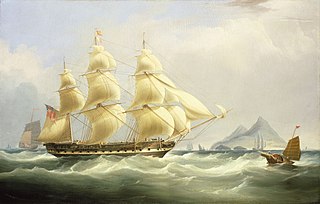Britannia may refer to any one of a large number of ships:
Coromandel was the French prize Modeste, captured in 1793 and refitted at Chittagong, British India. She made two voyages transporting convicts to Port Jackson, the first for the British East India Company (EIC). A French privateer captured her in 1805 but she had returned to British hands before 1809. An American privateer captured her in 1814 but this time the British Royal Navy recaptured her within days. She foundered in Indian waters on 6 February 1821.
Numerous ships with the name Phoenix, for the constellation or the mythical bird, have sailed for the British East India Company (EIC) between 1680 and 1821:
Numerous vessels have borne the name Coromandel, named for the Coromandel Coast.
Earl of Mornington, was a merchant vessel of 500 tons burthen (bm) built at Bombay Dockyard of teak and launched in 1766 or 1768. She made three voyages under charter to the British East India Company (EIC) under the command of captain Benjamin Ferguson. She does not appear in Lloyd's Register until 1804 and no longer appears in either Lloyd's Register or in the Register of Shipping in 1810.

Four vessels with the name Princess Royal have served the British East India Company (EIC).

A number of ships with the name Asia served the British East India Company (EIC) as East Indiamen:
At least two vessels have borne the name Lady Shore, named for Lady Charlotte Shore, wife of Sir John Shore. Because these two vessels were launched within a year of each other, they are frequently conflated. Hackman conflates the second of these vessels with the Lady Shore launched at Calcutta in 1803.
Numerous British vessels that have served the British East India Company (EIC) have borne the name Prince of Wales, after the then current Prince of Wales, the title borne by the heir-presumptive to the throne of the United Kingdom.
Two vessels named His Majesty's Hired armed cutter Industry briefly served the British Royal Navy during the Napoleonic Wars as hired armed vessels.
Several ships have borne the name Duke of Clarence, named for one or another Duke of Clarence, originally Prince William, the first Duke of Clarence and St Andrews, who acceded to the throne as William IV of the United Kingdom, but later the Duke of Clarence and Avondale:
Several British vessels were named Earl Spencer for one or another of the members of the Spencer family:
Henry Dundas was an East Indiaman launched in 1786 that made six voyages for the British East India Company (EIC). She was broken up in 1804.
Kingsmill was a French vessel launched in 1793 under a different name, captured in 1798, and sold to British owners who renamed her. She then became a slave ship, making three voyages from Africa to the West Indies. A French privateer captured her in 1804, but she returned to her owners in 1804. In 1807 she became a West Indiaman. In 1814 she became the first ship to trade with India under a license from the British East India Company (EIC) after the EIC lost its monopoly on British trade with India. She was badly damaged in 1821 and subsequently disappears from the registers.
Several ships have been named Caesar for Julius Caesar:
Melville Castle was launched in 1786 as an East Indiaman. She made seven voyages for the British East India Company (EIC). She was sold in 1802 to Dutch owners and wrecked with great loss of life later that year on her first voyage for them.
Duckenfield was launched in 1792 on the Thames. She was primarily a West Indiaman but between 1803 and 1805 she served the Royal Navy as an armed defense ship. She was last listed in 1819.
Lord Forbes was launched at Chester in 1803 as a West Indiaman. She soon became an "armed defense ship", but by 1805 had returned to being a West Indiaman. She made two voyages as an "extra" ship for the British East India Company (EIC). She continued trading with India until 1817 when she sustained damage on her way to Bengal. There she was surveyed, condemned and sold.
Several ships have been named Swallow for the bird Swallow:
Isabella was launched in France in 1791 as the East Indiaman St Jean de Lone. Two British privateers captured her in 1793. She was sold in prize and renamed Isabella. She initially sailed as a West Indiaman and then between 1795 and 1798 made two voyages to India as an "extra" ship for the British East India Company (EIC). Afterwards, she returned to the West Indies and Baltic trades and was last listed in 1809, but with data stale since c.1802.
This page is based on this
Wikipedia article Text is available under the
CC BY-SA 4.0 license; additional terms may apply.
Images, videos and audio are available under their respective licenses.

